ALSACAT-0000-00-00-TAENNCHEL-1
The Taennchel is a peak in the Vosges, in the Haut-Rhin, not far from Ribeauvillé. It raised questions, legends, and fantasies, because along its ridge there is a so-called "pagan" wall of nearly 2.3 kilometers, and on the ground, rocks with various engravings, some of which remain of debated origin.
When an Alsatian ufologist, Michel Padrines, in the years 2005, announced, according to his words, the discovery of statuettes which would come from it, and pointed out a rock engraved of a man looking at what would be three flying saucers, the place became "ufological", entering the casuistry of the theoreticians of the "Ancient Astronauts", thesis launched by Robert Charroux, Jacques Bergier and others in France, then Erich von Daniken, then a host of others. The idea is that ancient traces of extraterrestrial visitation are easily found in archaeological remains such as objects, statuettes, engravings, writings and monuments themselves.
In this file, I reconstruct the reality of the case, much less sensational than what was told, and in no way a discovery of Michel Padrines.
| Date: | Year zero. |
|---|---|
| Time: | N/A. |
| Duration: | N/A. |
| First known report date: | 1995 |
| Reporting delay: | 2000 years. |
| Department: | Haut-Rhin |
|---|---|
| City: | The Taennchel. |
| Place: | Mountain and forest terrain. |
| Latitude: | 48.240 |
| Longitude: | 7.269 |
| Uncertainty radius: | 3 km. |
| Number of alleged witnesses: | 0 |
|---|---|
| Number of known witnesses: | 0 |
| Number of named witnesses: | 0 |
| Witness(es) ages: | 0 |
| Witness(es) types: | 0 |
| Reporting channel: | Ufologist in "Ancient Astronauts" book. |
|---|---|
| Type of location: | Mountain and forest terrain. |
| Visibility conditions: | N/A. |
| UFO observed: | No. |
| UFO arrival observed: | N/A. |
| UFO departure observed: | N/A. |
| Entities: | No. |
| Photographs: | Yes. |
| Sketch(s) by witness(es): | No. |
| Sketch(es) approved by witness(es): | No. |
| Witness(es) feelings: | N/A. |
| Witnesses interpretation: | N/A. |
| Hynek: | N/A |
|---|---|
| ALSACAT: | Probable fraud. |
[Ref. lbn1:] LUC BURGIN:
The author explains that the French authorities keep ten stone finds under lock and key, including statuettes, one more curious than the other and which exert a strange fascination.
The imposing stones are strewn with strange grimaces, mysterious figures and crescent-shaped flying objects, causing, he says, only worry to French archaeologists, because their makers are hiding in the darkness of the past human, "where only those who do not aspire to a scientific career venture."
He says that the statuettes were found on the Taennchel, a legendary mountain range in the Vosges range in Alsace in France, a mountain whose summit is only accessible by foot, which with its ancient formations of stone has always stimulated the imagination of poets and thinkers. He adds that while some praise the Taennchel simply as a "unique place of power", others see it as a Germanic sanctuary.
He assures us that these theories are not correct, because mountains like the Taennchel "disturb scientific representatives" and attract amateur researchers, such as dowsers and esotericists, our "strange contemporaries who escape reality with a clear conscience."
He says that the forester Marc Schultz, of Sainte-Croix-aux-Mines, is the one who managed to preserve the strange statuettes, because without his intervention, they would have been secretly sold to interested collectors, as it often happens.
Burgin says he visited Schultz with a colleague in the village of Grand Rombach, where he lives isolated from the outside world. He told them his story and patiently answered all the questions.
It started in 1995, when friends contacted him to tell him enthusiastically that they had found four statuettes on the Taennchel under the rock formations. One in the parish of Thannenkirch and the other three in the parishes of Rorschwihr and Rodern.
He asked them to give him the objects temporarily to examine them with Joël Schweitzer, curator of the Mulhouse Historical Museum. They came to the conclusion that the finds were obviously from the Gallo-Roman era, probably made by Celts who had retired to hidden corners of the Vosges.
Schultz has decided not to talk about it in order to preserve the site for professional investigation. He was going to ask for permission to investigate the Thannenkirch site and his friends would take care of Rorschwihr and Rodern's items and also inform the respective authorities.
But on the spot, he discovered that people were busy digging at the sites of the finds. He called his friends and confronted them, but they defended themselves: the objects they had found protruded from the ground, they had only picked them up. They thought someone might have seen them at the time.
Schultz did not believe them at all and hastened to have the site inspected by representatives of the Regional Archaeological Service and alerted the town hall of Thannenkirch. He also called on his friends to show up with their three statuettes and urged them to contact the authorities in Rohrschwihr and Rodern, as had been agreed.
But the "friends" betrayed him, and furthermore, local archaeologists lost interest in the Thannenkirch statuette when they visited the site.
Christian Jeunesse from the Regional Directorate of Cultural Affairs in Strasbourg explained to Burgin that the sculptures were probably not more than 100 years old, that it was perhaps made by a sect, and that it "does not deserve any interest." At first, the expert did not want to know anything about the other statuettes.
Schultz was devastated, especially since the objects had not even been scientifically examined. Disappointed and angry, he decided to investigate the case on his own. The first thing he did was go back to his "friends" by surprise. When he arrived at their house, he couldn't believe his eyes, because there were three more objects, which they had discovered in the meantime on the Taennchel.
His friends provided countless excuses for not informing the authorities, and were said to be in dire need of the money so that they had decided to secretly sell the found objects to the highest bidder. They went so far as to ask Schultz to return the Thannenkirch statue to them. He then informed the authorities of what was happening.
The alarmed town hall finally notified the Ribeauvillé gendarmerie, which confiscated the mysterious finds. Schultz cannot explain that his "friends" were not prosecuted. He does not know why either, but the seven statuettes were then handed over to the Unterlinden museum in Colmar, where they "disappeared into the basement as quickly as they had arrived", without "a scientific investigation having been carried out to my knowledge."
Calm returned to the Taennchel, but in 1997, Marc Schultz discovered the car of his "friends" in the parking lot of the Rotzel, with various "treasure hunter" utensils inside.
He then discovered what he feared: "They searched the mountain up there with a metal detector." History repeated itself: once again Schultz called the authorities, again local police found three statuettes in the homes of the greedy treasure hunters.
After French researcher Guy Trendel and other amateur archaeologists began to take an interest in the finds soon after, French media got involved. In several articles and reports, local journalists put the headlights on the Taennchel mystery in all its facets. The majority of archaeologists kept a low profile, the objects found at the Taennchel did not fit into any common grid.
The representative of the attitude of "official archeology", Jean-Luc Bredel of the Ministry of Culture and Communication of the Prefecture of the Alsace Region in Strasbourg was questioned about the findings of Taennchel, and replied by letter on July 5, 2001 that "this case has been going on for several years now. It has been the subject of two legal proceedings, various reports, numerous articles and a television program to which some of my colleagues have participated."
The objects in question, Bredel continued, were "for some of them very strange and certainly of aesthetic interest", but could not be attributed to any earlier era. "It is most likely the work of an artist who worked in this sector a few decades ago. Anyway, the statuettes were made in the 20th century."
In the same letter, "occult ceremonies" are reported to have taken place on the Taennchel, with Bredel indicating that the place "attracts many Radiestheisists, Celtomaniacs and ET buffs."
Burgin says he then looked for reliable test results in French specialized scientific journals. but he did not find a word on the statuettes of the Taennchel.
At the end of 2001, he asked the Unterlinden Museum where the statuettes were, but no one thought it necessary to answer him. In the summer of 2002, he sent a follow-up email, after which the museum assured him that his request would be forwarded to the head of archaeological collections, Suzanne Plouin. But nothing happened.
Burgin explains that he knows the slowness of the French administration but that his patience was running out; he tried his luck at a higher step at the Regional Directorate of Cultural Affairs (DRAC) in Strasbourg. But even the director Jean-Luc Bredel did not consider it necessary to take a personal position on the Taennchel statuettes. Instead, he replied that it was necessary to contact the Unterlinden Museum directly about this...
However the regional curator of archeology at the DRAC, Frederik Letterlé, had received a copy of the letter, "and, miracle", a few days later Letterlé contacted Burgin to ensure that several expert opinions on the statuettes had already been given, and that "Everyone has come to the conclusion that it must be a modern object."
Burgin was not satisfied: "The question marks remained: in which scientific journals were the studies published? Since when can the age of a stone be measured with such precision? And "who is supposed to have quietly made the statuettes over the past hundred years and then secretly buried them" in the mountain?
On August 12, 2002, Letterlé told him that "The research has not yet been published". There would have been a request for expertise by Justice, a second expertise was ordered from the National Council for Archaeological Research in Paris. But these reports "can currently only be viewed in relevant institutions - and only with special permission."
Burgin says he objected: "Isn't it true that stones cannot be dated at all?" and Letterlé would then have admitted that.
Burgin explains that if the Taennchel objects seemed to confuse archaeologists, it was surely because some of the objects show "pyramid-shaped mountains with strange clouds, which, from today's perspective, can easily be interpreted as "flying saucers". "
He then explains that Letterlé told him that, precisely, the drawings of "flying saucers" on objects of the Taennchel proved that they were recent since such representations "appeared with the world of extraterrestrials only in the 1930's".
I can imagine what Burgin thought of this reasoning; he adds that there is not a word on the fact that the "saucers" of the Taennchel could also be stylized clouds. He storms: "I refrained from disturbing the French any more. You might as well explain the Internet to a wildebeest, I said to myself. The chances that he will one day send us an email are extremely slim..."
Shortly after, out of the blue, the Unterlinden Museum responded. Suzanne Plouin, the archaeologist in charge, was very helpful. Interestingly, still according to Burgin, unlike Letterlé, she was much more careful when it came to classifying the objects, saying: "The statuettes are provisionally in our archives as their legal status has not yet been clarified. They have been reviewed by many experts. Their historical relevance is still controversial today."
Finally, at the end of October 2002, surprise, after a long exchange of letters, Suzanne Ploudeckt authorized him to see the objects and take photographs at the Unterlinden museum in Colmar. Burgin says some of them are a bit bigger than a fist, others so big they could barely be lifted with two hands.
Suzanne Plouin shrugged her shoulders, recalling the doubious origin of the statuettes, and explains that it is by order of the Gendarmerie that they were stored at the museum since several years. She finds them "quite aesthetic. And the clouds in the shape of a saucer..."
Burgin said he was fascinated: "I also felt that I was holding objects that were of particular importance in ancient times. Witness to a time when man and nature still lived in harmony."
He notes that besides Marc Schultz, the French researcher Guy Trendel also doubts that the objects are fakes, Fritz Krauss of Reutlingen, "amateur researcher and expert in prehistory", studies them, and is part of the group of the "pros". Krauss thinks that even if they were fakes, they are wonderfully made. From the point of view of their appearance, the statuettes can in reality only be old. They may even be Old Germanic, that is, more than 2000 years old."
Burgin concludes with a questioning:
"What were they used for? Who do they represent? What do the mysterious signs mean? Nobody knows. Only the Taennchel knows their secret."
His chapter on the Taennchel objects includes around ten photos of the objects, which he himself took at the Unterlinden Museum in Colmar.
There are about ten sculptures of heads, and two stones comprising what would be the possible "flying saucers". I cover this in the Discussion at the bottom of this file.
[Ref. mps2:] MICHEL PADRINES:
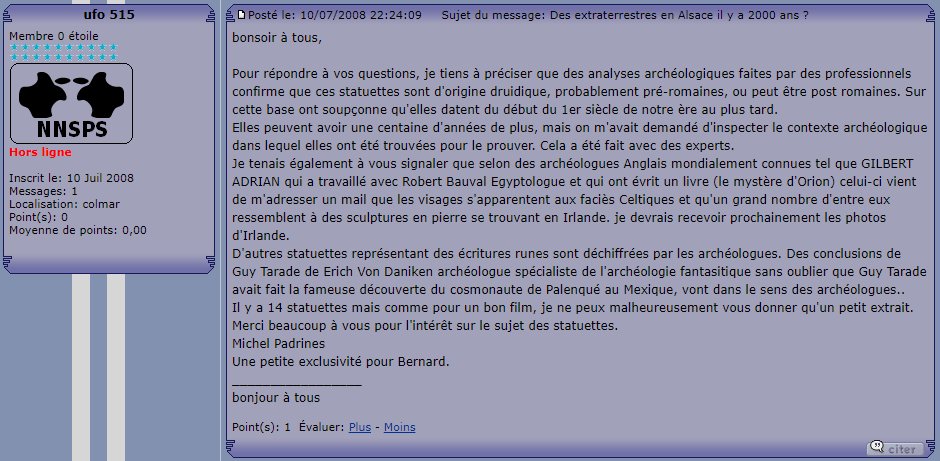
|
ufo 515
Member 0 star
Off line
Registered on: Jul 10, 2008
Messages: 1
Localization: colmar
Token(s): 0
Tokens average: 0,00
Good evening everyone,
To answer your questions, I would like to point out that archaeological analyzes carried out by professionals confirm that these statuettes are of druidic origin, probably pre-Roman, or perhaps post-Roman. On this basis it is suspected that they date from the beginning of the 1st century AD at the latest.
They may be a hundred years older, but I was asked to inspect the archaeological context in which they were found to prove it. This was done with experts.
I also wanted to point out that according to world famous English archaeologists such as GILBERT ADRIAN who worked with Robert Bauval Egyptologist and who wrote a book (the mystery of Orion) he has just sent me an email that the faces resemble Celtic facies and that many of them resemble stone carvings found in Ireland. I should soon receive the photos from Ireland.
Other statuettes representing rune writings have been deciphered by archaeologists. Conclusions of Guy Tarade by Erich Von Daniken archaeologist specializing in fantasy archeology without forgetting that Guy Tarade had made the famous discovery of the cosmonaut of Palenqué in Mexico, go in the direction of archaeologists.
There are 14 statuettes but as for a good film, unfortunately I can only give you a small extract.
Thank you very much for the interest in the topic of the statuettes.
Michel Padrines
A little exclusive for Bernard.
hello everyone
Point(s): 1 Rate: Plus - Minus
[Ref. dna1:] SITE WEB DU JOURNAL "DERNIERES NOUVELLES D'ALSACE":
In the mid-1990s, Marc Schultz was behind the arrest of looters raging in the Taennchel massif. "They undertook savage excavations with a metal detector from 1994 to 1997", Marc Schultz thinks. At the time of their arrest, the looters were in possession of nine statuettes, presumably of primitive art. They had also managed to sell hundreds of archaeological pieces. During the reconstruction carried out by the gendarmes, the looters indicated the places and the various hiding places where the objects had rested, certainly for centuries.
Most of the statuettes were found together in a cache under rocks. "The origin of these statuettes remains mysterious. For me, they are very old. I also discovered signs similar to those of Glozel. At the time, I went to see Emile Fradin, the discoverer of the proto-runes of Glozel. He told me: "Here you go with 80 years of trouble! When he was 16, he had come across signs inscribed on reindeer antlers dating back between 12 and 15,000 years. He had all the difficulties in the world to have these signs authenticated and recognized as authentic. He had been accused of being a forger. Finally, the pieces were considered authentic but dating from the Gallo-Roman period. However, these reindeer had already disappeared at that time. The scientific community is afraid to question its hypothesis that Mesopotamia is the cradle of writing. It would call too many things into question.
No archaeologist has yet looked into the mysterious statuettes of Taennchel.
[Ref. zpl1:] "ZONE PARANORMALE" WEBSITE:
AUGUST 28, 2017
Written by Rosyvalerie and published from Overblog
The mysterious statuettes of Taennchel in Alsace
UFOs sculpted by our ancestors?
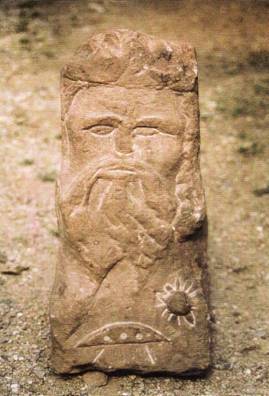
Above: statuette discovered on the Taennchel site in Alsace. Under the face, a strange shape that evokes a "flying disc". Two appendages protrude from the lower part. Perhaps it is two rays of light or more simply the feet of the "craft". The white underline which surrounds the "flying disc" and the symbol above on the right was made by the gendarmerie (sources Michel Padrines).
These statuettes provided a lot of commentary. The questions raised by this fantastic discovery were plausible, subject to laborious verification.
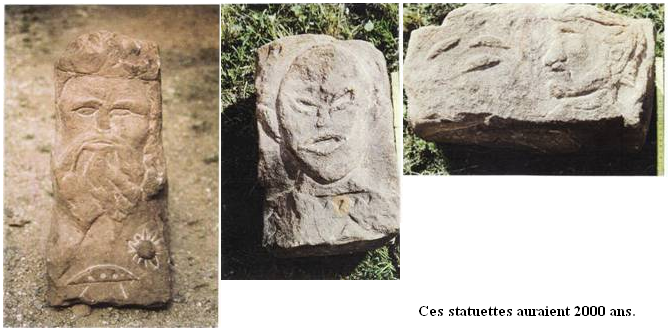
In 1997, a megalithic site was the object of two lootings, a dozen statuettes were found by the Gendarmerie. There was reconstruction of the break-ins and authentication of the stones with the gendarmerie.
On these stones are engraved many UFO phenomena.
Archaeologists and professional experts (German, English, French, give their conclusions a date of around 2000 years. Some archaeologists find it very difficult to recognize it because of the strange things which are engraved on it and which disturb them.
These statuettes are now in a museum in Alsace, in a basement and forbidden to see them for the public, why?
I went to the site in question for various studies with archaeologists, experts, dowsers etc... I have just requested a televised debate on FR3 Alsace, in order to meet the people of the Ministry of Culture of Alsace, I requested the presence of archaeologists, and experts for this debate.
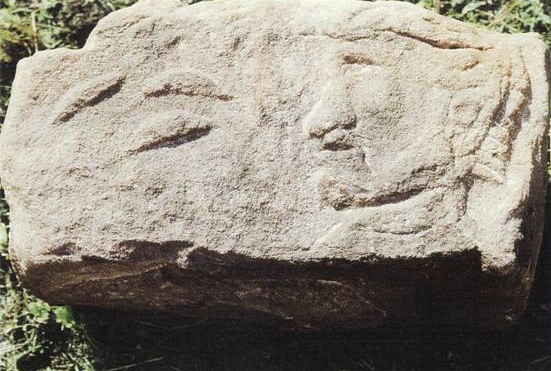
Above: statuette discovered on the Taennchel site in Alsace. To the right of the photo, a man seems to be looking at a formation of three objects (on the left of the image) moving in front of him (sources Michel Padrines).
Why did the Ministry of Culture never assess these famous statuettes?
A letter has just been sent to the President of the Republic requesting his intervention in this study. I send a message to the gentlemen of the DRAC (Regional Directorate of Cultural Affairs) should consider the mysterious archeology from a serious angle: Indeed, it is based on visible, tangible objects, suitable for examination, but who are still far from having revealed all their secrets. Michel Padrines gave exclusively to Les Repas Ufologiques the 1st photos of his new book "OVNI INVESTIGATION" (Source: Les Repas Ufologiques)
These are the results of methodical research on the UFO phenomenon, of extraordinary but nevertheless very real appearances, that Michel Padrines presents to us in this book.
However, whatever name one gives to these demonstrations, which probably date back to millennia, the author analyzes with accuracy and precision the most disturbing cases he has encountered in the field.
Convinced of the physical and paraphysical reality of this impressive reality, his investigative skills enabled him to tackle taboo subjects that many ufologists reject, not daring to tackle them.
On archaic archaeological sites like that of Mount Taennchel, Michel Padrines found sculpted stones representing heads with completely unknown facies. On the latter are engraved designs evoking mysterious craft bearing a strong resemblance with the celestial objects that have haunted our skies for more than sixty years.
In Senegal, he interviewed the last witnesses to a drama that remained hidden by the media, that of two villages grazed by a UFO!
As many ufologists know, they disturb those who hold the unique thought. Michel Padrines him, is not moved because he pondered the quote from Herbert Spencer: "There is a principle which makes it possible to block all information, to refute any argument and which cannot fail to keep men in a position. perpetual ignorance: This principle is expressed thus, condemn before asking!". (Guy Tarade).
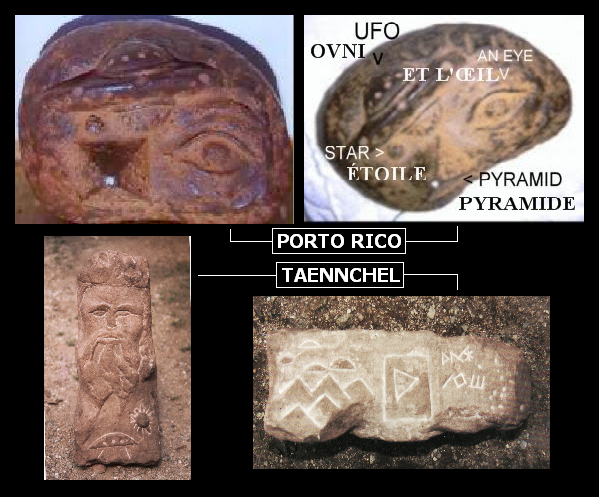
We find: The UFO, the star in the statuette on the left, without forgetting the 4 white dots in the two UFO sculptures (from Taennchel and Puerto Rico).
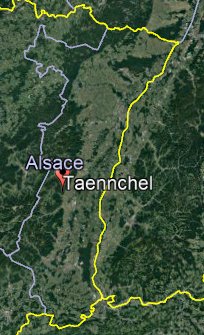
|

|
I have to deal with various questions more or less peripheral to the case.
As a forest ranger in the valley of Sainte-Marie-aux-Mines near the Taennchel, Marc Schultz knows the place very well, he is passionate about the past of the place and what, according to him, connects it to other mythologies in the world. He was always ready to introduce Taennchel to neophytes during guided tours, he is co-author of the book "Haut-Koenigsbourg, Frankenbourg, Taennchel : Triangle Tellurique" with Bernard Riebel, and is involved in the album "Taennchel - Terre Lointaine" as a voice-over. See among others, the website https://taennchel.com
In the press article [dna1], Marc Schulz mentions Glozel. Glozel is a French hamlet in the Allier department near which a young boy, Emile Fradin, had found ancient-looking artefacts in 1924, notably tablets bearing "unknown" writing. This resulted in an interminable controversy: according to some, it was Fradin who made the objects, according to others, that writing was invented in Glozel 12,000 years ago and not in Mesopotamia 5,100 years ago. According to others, aliens are involved.
I investigated the case. But I haven't written anything yet, so I can only make these statements here that I could only substantiate later:
The whole affair presented by Marc Schultz and then Luc Burgin had remained very confidential - Burgin's book, in German, was not published in French or English. It was revived with echoes on the Internet by Michel Padrines, who "appeared" in ufology in Alsace in the 2000s. I had met him then at a quite interesting ufology conference by Pierre Lagrange, which he had organized near from Colmar. Also appeared on video projection "former" Guy Tarade, urging ufologists to "stop their quarrels" etc. Michel Padrines struck me as an affable and cordial man, and I took the opportunity to buy him a copy of his self-published book whose (awful) title was "UFO Génération OVNI".
When I read the book, I was quite dismayed to find that it was essentially made up of "copied / pasted" content from two ufology websites: mine, and the RR0 website by Jérôme Beau. Even our misspells were copied, and the worst was to find that Michel Padrines was writing "my investigation" about a case from 1954. It was in no way an investigation but a commentary on a case, it was not his but mine, and he had "pasted" it to the wrong case! Do I need to add this: no source, no mention of my website or that of Jérôme Beau was made.
I have absolutely nothing against copycats of my website. Do what you want! But, it goes without saying that in my opinion, a "researcher" who copies the work of others, without citing their sources, without any added value, presenting what they copy as their own "research" - with paste errors - is not really a researcher... to be polite.
Subsequently, one could read on various websites dealing with UFOs, or the paranormal, a presentation of his new book, explaining in particular that "On archaic archaeological sites such as that of Mount Taennchel, Michel Padrines has found sculpted stones representing heads with totally unknown faces. On the latter are engraved drawings evoking mysterious craft having a strong resemblance to the celestial objects that have haunted our skies for more than sixty years. (This was written by Guy Tarade.)
As can be seen in my file, Michel Padrines did not "discover" anything at all in the Taennchel: everything is based on what Marc Schultz and Luc Burgin had written.
Michel Padrines died in 2011, and his 2008 book which would relate "his" discoveries is obviously untraceable to me.
Below: announcement on the web of the release of Michel Padrines' book with a different cover in 2009.
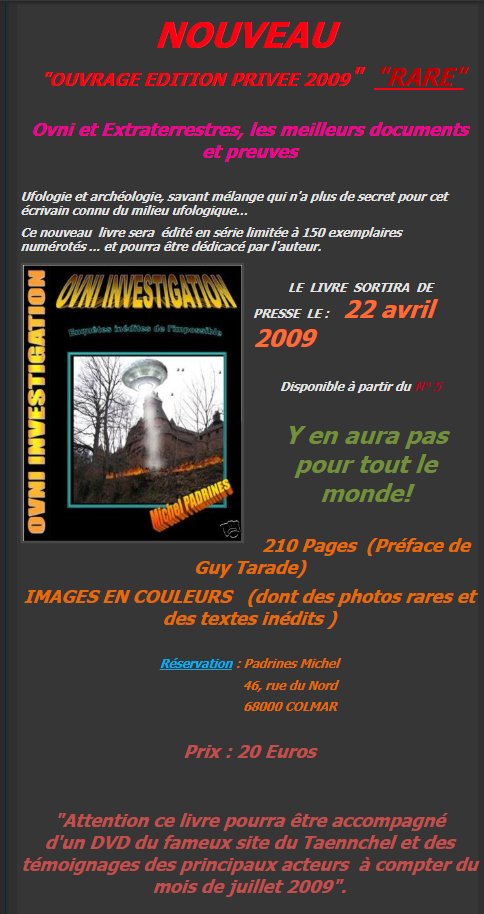
|
It was not necessary for me to resume in extenso all the web pages that appeared after Michel Padrines relaunched the case; especially since most of them just copy the others. I give some examples here:
On the web, you can find this piece of text everywhere:
A dozen statuettes were found in 1997 by the gendarmerie in Taennchel in Alsace on a megalithic site. Authenticated by professional archaeologists, they would be around 2000 years old. What makes these statuettes so extraordinary? Well the fact that the drawings engraved on them correspond to numerous UFO sightings. Today, these statuettes are in the basement of an Alsatian museum away from the public.
An example of 2022 of advertising for a Taennchel hike organized by a "well-being coach":
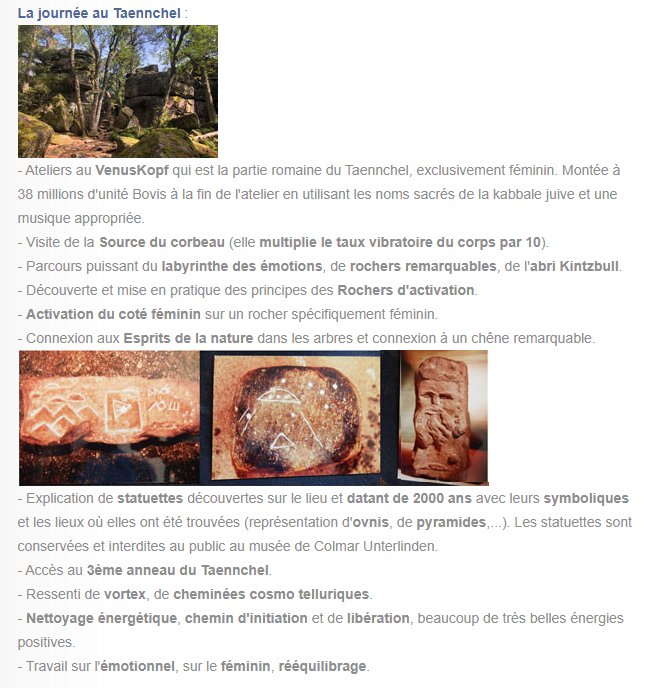
|
The day at Taennchel:
- Workshops at VenusKopf which is the Roman part of Taennchel, exclusively female. Rise to 38 million Bovis units at the end of the workshop using the sacred names of Jewish Kabbalah and appropriate music.
- Visit the Source of the Raven (it multiplies the vibratory rate of the body by 10).
- Powerful course of the labyrinth of emotions, remarkable rocks, the Kintzbull shelter.
- Discovery and practice of the principles of the Rocks of activation.
- Activation of the female side on a specifically female rock.
- Connection to the Spirits of Nature in the trees and connection to a remarkable oak tree.
- Explanation of statuettes discovered on the site and dating back 2000 years with their symbolism and the places where they were found (representation of UFOs, pyramids,...). The statuettes are preserved and prohibited to the public at the Colmar Unterlinden museum.
- Access to the 3rd ring of Taennchel.
- Feeling of vortex, of cosmo telluric chimneys.
- Energy cleansing, path of initiation and liberation, lots of very beautiful positive energies.
- Work on the emotional, on the feminine, rebalancing.
The "data" on the web, essentially, is two images with a comment. Here's the first one:
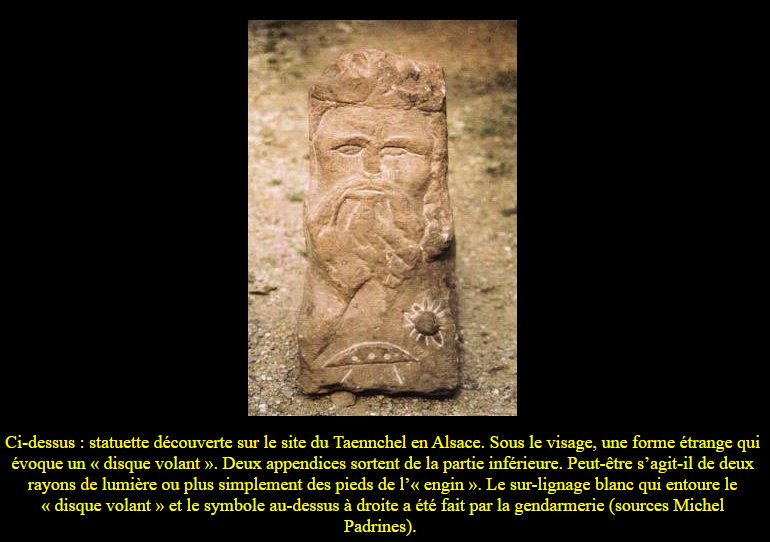
|
Above: Statuette discovered at the Taennchel site in Alsace. Under the face, a strange shape that evokes a "flying disc". Two appendages emerge from the lower part. Perhaps it is two rays of light or more simply the feet of the "craft". The white highlighting that surrounds the "flying disc" and the symbol above on the right was made by the gendarmerie (sources Michel Padrines).
The second one:
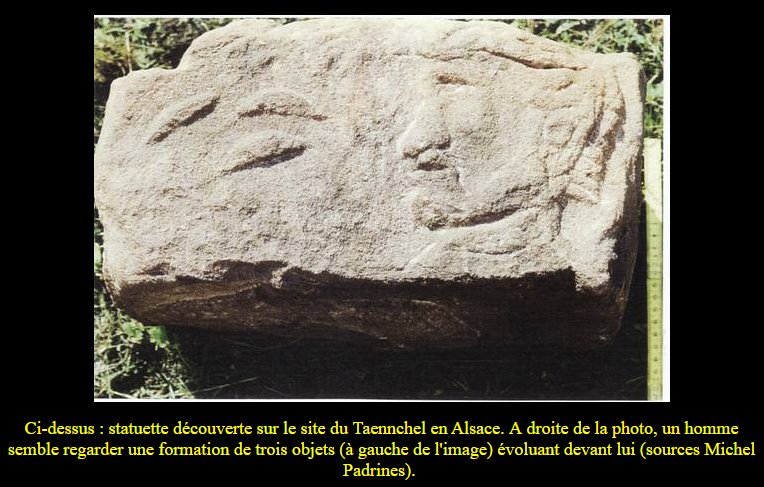
|
Above: Statuette discovered at the Taennchel site in Alsace. On the right of the photo, a man seems to be watching a formation of three objects (on the left of the image) moving in front of him (sources Michel Padrines).
As can be seen here, the "discovery" of the statuettes goes back to Marc Schultz, with the intervention of the Gendarmerie on the grounds of either illegal excavations or fraud; it is then the Swiss Luc Bürgin who gave the ufological echo of the affair, Michel Padrines only followed later.
At the simple sight of the images, it is obviously impossible to affirm that the engravings of "flying saucers" on some of the statuettes are "vintage" or a simple modern fraud. It is not even possible for the moment to affirm that the statuettes are from the period.
The "discovery" was not made by professional archaeologists, but by people of whom we don't know much, and in a generally "shady" context.
The "world famous archaeologists" claimed by some to have "authenticated" the statuettes are essentially "unidentified". "Gilbert Adrian", in fact "Adrian Gilbert", is a prolific author of books on the "Grail", the Templars, and other mysteries which he sensationalizes. Robert Bauval is an author of the same trend, he is not an Egyptologist but an engineer.
Probable fraud.
*=Source is available to me.
?=Source I am told about but could not get so far. Help needed.
| Main author: | Patrick Gross |
|---|---|
| Contributors: | None |
| Reviewers: | None |
| Editor: | Patrick Gross |
| Version: | Create/changed by: | Date: | Description: |
|---|---|---|---|
| 0.1 | Patrick Gross | September 4, 2022 | Creation, [lbn1], [mps2], [dna1], [zpl1]. |
| 1.0 | Patrick Gross | September 4, 2022 | First published. |